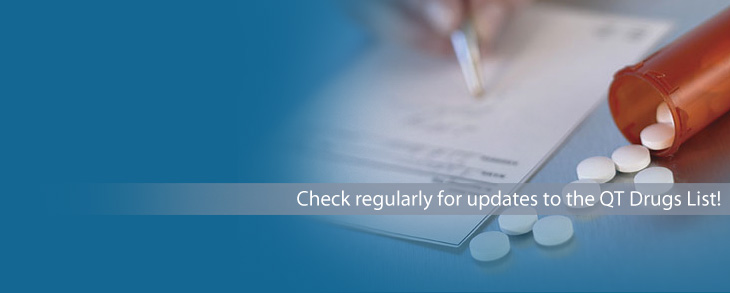Long QT Syndrome (LQTS) - Clinical Overview
Overview of Long QT Syndrome and Torsades de pointes
Michael Kilborn January 19, 2005
Discussion of the long QT syndrome and its associated life-threatening arrhythmia, torsades de pointes, can become somewhat esoteric, even for cardiologists. It is, however, an important syndrome for all physicians and health-care providers to be able to recognize and manage, because it can occur as a life-threatening side effect of so many medications.
Recognition of torsades de pointes and LQTS:
Recognition of torsades de pointes ultimately requires ECG recordings showing occurrence of polymorphic ventricular tachycardia, and that the patient has an abnormally long QT interval when in normal rhythm (usually sinus rhythm, but atrial fibrillation in some patients). There are other electrocardiographic features associated with torsades, including lability of the long QT intervals, prominent U waves, and a "pause-dependent" onset of the arrhythmia. But our patients can't be on ECG monitors every time they start a new drug, so how can health-care providers decide who needs to have ECGs done, and when? To answer this, all you need to understand are the symptoms of torsades, and the risk factors for its occurrence:
Symptoms:
Torsades is one of the heart rhythms (like ventricular fibrillation and asystole) that produces essentially no effective cardiac output when it is occurring. Therefore, if episodes last more than about 10 seconds, the "symptom" that they produce is collapse with unconsciousness, sometimes associated with tonic-clonic seizure activity due to brain hypoxia. If the rhythm doesn't terminate within a minute or two, death is the result; if it does terminate, the patient will generally recover consciousness quite quickly.
Episodes of torsades may only last a few seconds, however. In that case, they may not cause loss of consciousness, but may make the patient feel any of the following:
- lightheaded,
- dizzy,
- awareness of their heart fluttering (palpitations),
- transient shortness of breath, or
- a sensation of their breath "catching" for a moment.
Risk Factors:
We have mentioned that long QT on the ECG is a "necessary" factor to make the diagnosis of torsades. However, by itself, a long QT may not lead to torsades very often, or ever, in some people. The risk of torsades starts to grow when long QT is combined with other risk factors:
- bradycardia, especially with occasional "premature" beats
- hypokalemia
- hypomagnesemia
- "stimulant" conditions such as exercise, emotion, or use of drugs like dopamine, epinephrine or even albuterol.
In addition to these risk factors, the risk factors for having a long QT include:
- congenital (often familial) abnormalities of cardiac membrane channels, and
- use of the various drugs which interact with some of those membrane channels (most notably the "HERG" potassium channel) to lengthen QT.
The answer to the question "how can health-care providers decide who needs to have ECGs done, and when?" now seems more obvious:
- anyone who has had an episode of (otherwise unexplained) cardiac arrest, blackouts or fainting, seizures,
- anyone complaining of episodes of (otherwise unexplained) lightheadedness, dizziness, palpitations or transient breathlessness,
- anyone with a slow pulse (less than 50)
- anyone who might have low potassium or magnesium (e.g. people being treated with diuretics)
- anyone with a family history of long QT syndrome, sudden death or unexplained blackouts
If the patient's symptoms are episodic and relatively frequent, it may be necessary to order a monitor that the patient can carry with them - a 24-hour "Holter" monitor if the symptoms occur every day, or an "event" monitor (also known as a loop recorder or transtelephonic monitor) if the symptoms are less frequent than daily.
If you're starting a patient on a new drug known to be able to prolong the QT, and if the patient has any of the above risk factors, or if the drug in question is one of the very potent QT-prolonging drugs such as quinidine, procainamide, dofetilide, sotalol, or amiodarone, then you may wish to obtain a pre-drug ECG and an on-drug ECG a day or two later.
Treatment of torsades de pointes and LQTS
Acute treatment of torsades includes:
- DC cardioversion shock to terminate sustained episodes (longer than 5 seconds),
- Intravenous magnesium, and
- Measures to obtain a relatively fast and regular heart rhythm - either cardiac pacing or isoproterenol infusion,
Then appropriate secondary preventative management includes:
- correction of underlying electrolyte abnormalities,
- withdrawal of any offending drugs.
- Consideration of permanent pacing and/or implantable defibrillator for refractory or high-risk patients
Which drugs can prolong QT?
The most potent at doing this are, somewhat paradoxically, two subsets of the anti-arrhythmic drugs - the so-called class Ias (eg quinidine and procainamide) and the class IIIs (eg dofetilide, sotalol and amiodarone).
Other drugs which can prolong QT have been found in most other classes of therapeutic agents, including anti-histamines, antibiotics, gastrointestinal prokinetics, antipsychotics, etc. Not all drugs have been subjected to the same testing for their QT effects, either in development or after marketing, so precise quantification of risk can be difficult, as can comparison of different drugs.
We have compiled and maintain lists of drugs for health-care providers to use as a first reference in this area; those lists can be found here. Because the evidence for risk is variable between the many drugs associated with torsades, we have divided the drugs into four groups. Each of the four lists of drugsrelate to their relative risk of inducing torsades or prolonged QT. Drugs are included on the lists based on information from the medical literature, the Food and Drug Administration (FDA)-approved drug labeling and reports submitted to the FDA Adverse Events Reporting System database. The drug lists also reflect a consensus of opinion of the QT Drugs Advisory Board.
These lists are updated periodically. The medical literature is continually growing, so our web-site provides a link to an immediate "PubMed" search of the literature for each of the drugs on the lists.
Do I stop the drug, decrease the dose, or simply eliminate other risk factors?
This question can only be answered on a case-by-case basis. The risks (modifiable and non-modifiable) of the particular drug in the particular patient must be balanced against the benefit obtained or expected from that drug, and the availability of non-QT-prolonging alternative drugs. For example, a patient in an Intensive Care Unit with acute septicemia sensitive only to a particular QT-prolonging antibiotic should receive that antibiotic, with appropriate ECG monitoring and readiness of treatment for torsades. On the other hand, a patient who has survived a cardiac arrest induced by a QT-prolonging antibiotic that was prescribed for mild bronchitis, should only take either a non-QT-prolonging antibiotic or probably no antibiotic at all, if he or she has another episode of mild bronchitis. A patient with a long QT in the absence of any drugs or other modifiable risk factors, and with a personal or family history of cardiac arrest, should be seen by a specialist cardiologist and considered for prophylactic beta-blocker treatment and/or defibrillator implantation.
Should I report my case?
The answer to this is a resounding "Yes". This is an area in which the promise of this new era of genomics and pharmacogenetics is great, but research in this area can only proceed if the cases of drug-induced torsades can be studied. Even if the drug involved is well known to be a potential cause of torsades, the important question becomes "why did this particular patient develop the arrhythmia when so many other patients exposed to the same drug do not?" If we can find answers to that question, then we will probably be able to develop tests to predict which patients are at risk from particular drugs, and which are likely to get the benefit of the drug without significant risk of torsades as a side-effect.
Cases can be reported to the International Registry of Drug-Induced Arrhythmias (also known for short as the QT Registry). Patients can be asked whether they will give a small sample of blood to allow genetic testing of their DNA. The Registry can also pass the report on, in confidence, to the drug manufacturer and the FDA if the submitting physician wishes.








